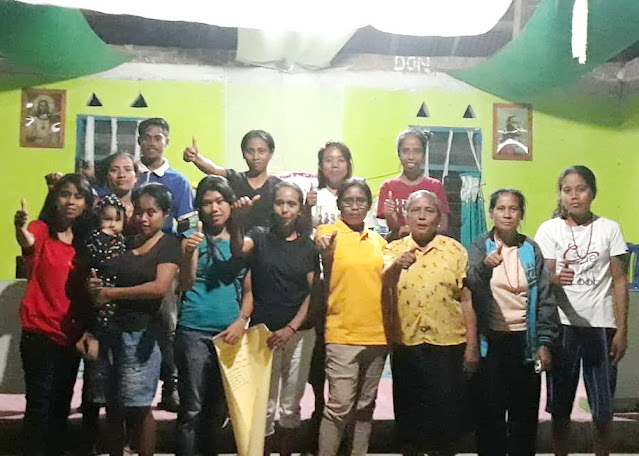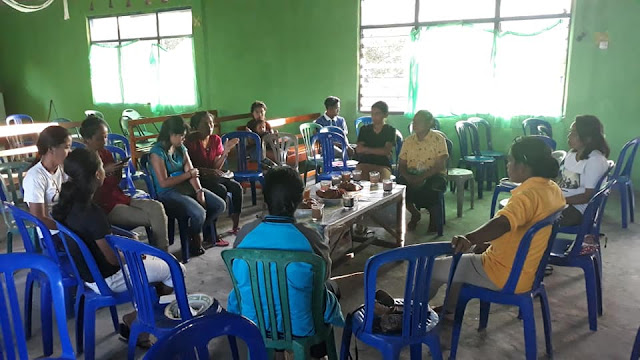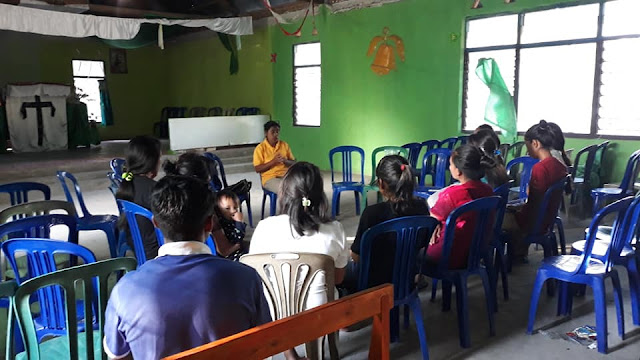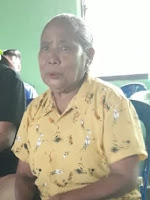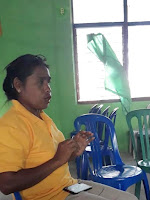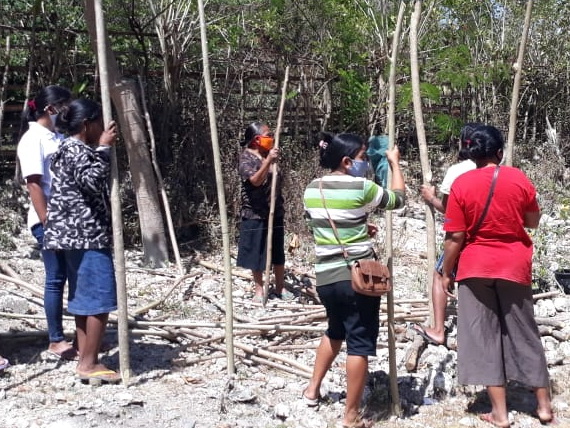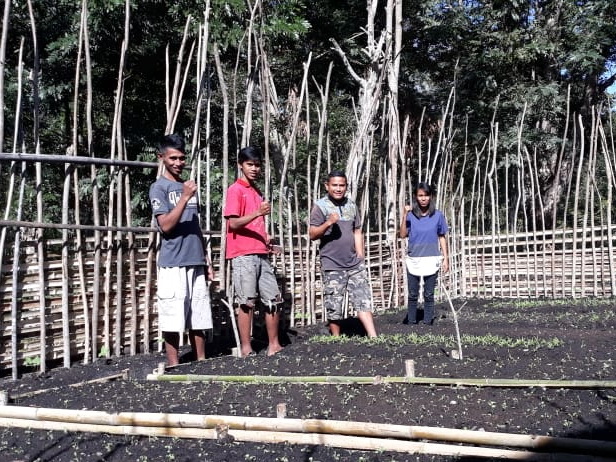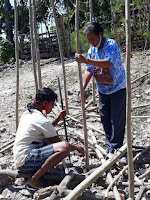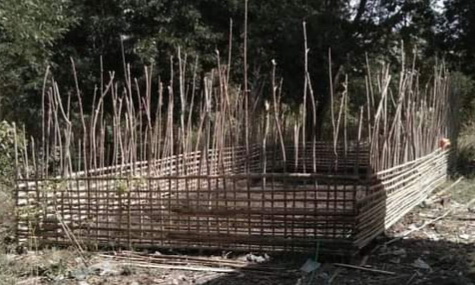All about Tied Weaving of Sumba
Monday, 10 August 2020by Elisabeth Uru Ndaya, S.Pd
Humans, both individual and group, cannot be separated from their identities as cultural beings. The culture itself consist of a set of attitudes, beliefs and behaviors communicated from generation to generation as means adopted by each society. The art of weaving is an old culture that humans are engaged in to produce clothing and heritage of civilization that almost be found all around the world. From the various woven fabrics of East Indonesia, in East Nusa Tenggara, Sumba is one of the islands producing woven fabrics which is very famous for its beauty and various motifs. Therefore, it is important to have inheritance and regeneration to young people as the next generation in order to maintain the cultural preservation.
On Sunday, August 9, 2020, Stube-HEMAT Multiplication Program in Sumba held a discussion at GKS Karunggu with a theme ‘Revealing the History about Tied Weaving of Sumba’, attended by dozens of women who have longing in weaving with Marta Harakay, a weaving craftswoman from Kalu, Kambera district, Waingapu. She said that people began to work on weaving since the 4th century to produce cloths. At that time the woven fabric was not made of yarn but spunned directly from cotton to make a piece of woven cloth. Each step, from tying the yarns, dyeing it until to the weaving process should be done carefully even sometimes it takes 6 months to 3 years because in addition to weaving and making motifs, the cloth should be aerated for a month before being dipped in candlenut oil. Another stage in making Sumba cloths also tests patience, such as storing them in a closed basket to ripen the color and the nature will involve in the process so that the cloth becomes more unique. Marts also explained the meaning of the motifs on the woven fabric.
The participants seemed so enthusiastic when listening the speakers’ explanations. Among them, there were 3 women who engaged in weaving but not all of them knew all process. They knew only the partly process, such as some others knew only about the yarns, coloring, or weaving, but no one knows each step, even the others did not understand at all. Astry Banju shared her story, she was known as a weaving craftswoman but actually she could not weave, only in dyeing and yarn-grouping, then her mother-in-law did the weaving, because when she tried to weave, the results were not good.
The different story from Mama Ferdi, she could do steps to weave, but she lacked experience in coloring, and the products were not good in colour, while Adriana Tanggu Hana wanted to weave but no one trained her, finally she did not do anything. She hoped this program gave her chance to learn weaving. The participants’ experiences above discovered new understanding that weaving need a long and persistent process. This discussion opened opportunity for them to collaborate each other, to learn from one to another and to share experiences.
Marta Harakay, the expert in weaving, reminded the participants that learning to weave is uneasy, but it needs strong commitment dan motivation to make it. She also gave some tips how to weave well to produce good stuffs, covering the sitting position, proper posture, tight back ties, plus the leg kicking to the loom must be strong enough. Likewise with the coloring, it is important to pay attention to the mixed ingredients and the color combination in order to get beautiful colors.
At the end of the discussion, they formed a weaving group called ‘Kawara Panamung’ with meaning of ‘embracing each other’. After that, they wrote on some pieces of paper their messages and hopes for the community they had formed. Hopefully, the group will help women to be creative and to produce good woven fabrics with Makamenggit's weaving typical, supporting the economic of women here. Next, the group will visit a weaving village to observe and to learn new things about weaving. ***
Women and The House Yards: Food Solution during Pandemic
Tuesday, 4 August 2020by Elisabeth Uru Ndaya, S.Pd
The dry season is the season when farmers in the southern part of East Sumba generally take rest, they do not farm or cultivate the land because the soil is dry, so it is difficult to grow any plants there. This condition is faced by farmers every year, especially in Lewa, Makamenggit area. Only during the rainy season they cultivate the land. The time span of the dry season is from May to November (8 months), and during that season most farmers, especially women, stay at home and rarely do other activities. Moreover, the pandemic force everyone to stay at home and make women unproductive.
This condition is not supposed to make people unproductive, instead various activities can be carried out, especially activities that can supply household food needs. One option that can be done is vegetable gardening in the house yards. This is what the women's community of Stube HEMAT is doing here. Started from an understanding how to take advantage of the existing potency as the facilitator of the discussion, Pdt. Suryaningsih Mila, M.Si. Teol, shared to the participants, it became a new enthusiasm to optimize the house yards by making vegetable beds.
On August 3, 2020, the women in this village started to set fence around the vegetable beds. There are two locations used, at the church yard for vegetables and at the yard of Iche Hana's house for the nursery of natural colouring plants for their traditional weaving. Iche Hana, a weaver and young activist, admitted that she was very happy with the enthusiasm of the women here to optimize their house yards, even dry, did not dampen their enthusiasm to synergize.
Kalita Mboru, a woman activist, the head of PAUD (pre-school) Bina Kasih, and also the head of Tanatuku village health team, commented about the establisment of women's community in this village. "I am happy for the Stube HEMAT program here, so the women here do not just prepare the food and stay at home, but we can support the economic condition of our family by planting vegetables and learning traditional weaving", she said. She thanked to Stube HEMAT for being ready to support the activity and there will be good cooperation.
The two vegetable beds that have been made require sufficient water during the dry season, however it did not reduce the motivation of the community to take advantage of the existing potency and help their families daily needs. They applied a method to pay monthly fee of Rp 5.000 per participant. From 20 members they bought a tank of water for Rp 100.000 per month to supply water needs for the vegetable beds and the nursery. Meanwhile, the community distribute schedule to take care the plantantion, such as watering and caring for the plants. Keep moving women to ignite enthusiasm and cooperation. ***



